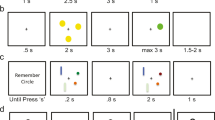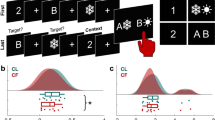Abstract
It has been proposed that working memory (WM) is updated/manipulated via a fronto-basal-ganglia circuit. One way that this could happen is via the synchronization of neural oscillations. A first step toward testing this hypothesis is to clearly establish a frontal scalp EEG signature of WM manipulation. Although many EEG studies have indeed revealed frontal EEG signatures for WM, especially in the theta frequency band (3–8 Hz), few of them required subjects to manipulate WM, and of those that did, none specifically tied the EEG signature to the manipulation process per se. Here we employed a WM manipulation task that has been shown with imaging to engage the prefrontal cortex and the striatum. We adapted this task to titrate the success of WM manipulation to approximately 50 %. Using time–frequency analysis of EEG, we showed that theta power increased over frontal cortex for successful versus failed WM manipulation, specifically at the time of the manipulation event. This establishes a clear-cut EEG signature of WM manipulation. Future studies could employ this to test the fronto-basal-ganglia hypothesis of WM updating/manipulation.



Similar content being viewed by others
References
Bäckman L, Nyberg L, Soveri A, Johansson J, Andersson M, Dahlin E, Neely AS, Virta J, Laine M, Rinne J (2011) Effects of working-memory training on striatal dopamine release. Science 333(6043):718
Baddeley A (2003) Working memory: looking back and looking forward. Nat Rev Neurosci 4(10):829–839
Benjamini Y, Hochberg Y (1995) Controlling the false discovery rate: a practical and powerful approach to multiple testing. J R Stat Soc Ser B Methodol 57(1):289–300
Canolty RT, Soltani M, Dalal SS, Edwards E, Dronkers NF, Nagarajan SS, Kirsch HE, Barbaro NM, Knight RT (2007) Spatiotemporal dynamics of word processing in the human brain. Front Neurosci 1:185–196
Cavanagh JF, Cohen MX, Allen JJ (2009) Prelude to and resolution of an error: EEG phase synchrony reveals cognitive control dynamics during action monitoring. J Neurosci 29:98–105
Cavanagh JF, Frank MJ, Klein TJ, Allen JJB (2010) Frontal theta links prediction errors to behavioral adaptation in reinforcement learning. Neuroimage 49:3198–3209
Cavanagh JF, Wiecki TV, Cohen MX, Figueroa CM, Samanta J, Sherman SJ, Frank MJ (2011) Subthalamic nucleus stimulation reverses mediofrontal influence over decision threshold. Nat Neurosci 14(11):2860–2870
Cavanagh JF, Zambrano-Vazquez L, Allen JJB (2012) Theta lingua franca: a common mid-frontal substrate for action monitoring processes. Psychophysiology 49(2):220–238
Cohen JD, Perlstein WM, Braver TS, Nystrom LE, Noll DC, Jonides J, Smith EE (1997) Temporal dynamics of brain activation during a working memory task. Nature 386(6625):604–608
Curtis CE, Rao VY, D’Esposito M (2004) Maintenance of spatial and motor codes during oculomotor delayed response tasks. J Neurosci 24(16):3944–3952
Dahlin E, Neely AS, Larsson A, Bäckman L, Nyberg L (2008) Transfer of learning after updating training mediated by the striatum. Science 320(5882):1510–1512
Deiber MP, Missonnier P, Bertrand O, Gold G, Fazio-Costa L, Ibañez V, Giannakopoulos P (2007) Distinction between perceptual and attentional processing in working memory tasks: a study of phase-locked and induced oscillatory brain dynamics. J Cogn Neurosci 19:158–172
Delorme A, Makeig S (2004) EEGLAB: an open source toolbox for analysis of single-trial EEG dynamics including independent component analysis. J Neurosci Methods 134(1):9–21
Frank MJ, Loughry B, O’Reilly RC (2001) Interactions between frontal cortex and basal ganglia in working memory: a computational model. Cogn Affect Behav Neurosci 1(2):137–160
Fries P (2005) A mechanism for cognitive dynamics: neuronal communication through neuronal coherence. Trends Cogn Sci 9(10):474–480
Gevins A, Smith ME, McEvoy L, Yu DH (1997) High-resolution EEG mapping of cortical activation related to working memory: effect of task difficulty, type processing, and practice. Cereb Cortex 7(4):374–385
Griesmayr B, Gruber WR, Klimesch W, Sauseng P (2010) Human frontal midline theta and its synchronization to gamma during a verbal delayed match to sample task. Neurobiol Learn Mem 93(2):208–215
Grossmann A, Morlet J (1985) Decomposition of functions into wavelets of constant shape and related transforms. In: Streit L (ed) Mathematics and physics, lectures on recent results. World Scientific, River Edge
Hazy TE, Frank MJ, O’reilly RC (2007) Towards and executive without a homunculus: computational models of the prefrontal cortex/basal ganglia system. Philos Trans R Soc Lond Biol 362(1485):1601–1613
Hsieh L-T, Ekstrom AD, Ranganath C (2011) Neural oscillations associated with item and temporal order maintenance in working memory. J Neurosci 31(30):10803–10810
Jensen O, Tesche C (2002) Frontal theta activity in humans increases with memory load in a working memory task. Eur J Neurosci 15:1395–1400
Kawasaki M, Kitajo K, Yamaguchi Y (2010) Dynamic links between theta executive functions and alpha storage buffers in auditory and visual working memory. Eur J Neurosci 31:1683–1689
Klimesch W, Freunberger R, Sauseng P, Gruber W (2008) A short review of slow phase synchronization and memory: evidence for control processes in different memory systems? Brain Res 1235:31–44
Lewis SJG, Dove A, Robbins TW, Barker RA, Owen AM (2003) Cognitive impairments in early Parkinson’s disease are accompanied by reductions in activity in frontostriatal neural circuitry. J Neurosci 23(15):6351–6356
Lewis SJG, Dove A, Robbins TW, Barker RA, Owen AM (2004) Striatal contributions to working memory: a functional magnetic resonance imaging study in humans. Eur J Neurosci 19:755–760
Lewis SJG, Slabosz A, Robbins TW, Barker RA, Owen AM (2005) Dopaminergic basis for deficits in working memory but not attentional set-shifting in Parkinson’s disease. Neuropsychologia 43(6):823–832
Luu P, Tucker DM (2001) Regulating action: alternating activation of midline frontal and motor cortical networks. Clin Neurophysiol 112:1295–1306
Luu P, Tucker DM, Derryberry D, Reed M, Poulsen C (2003) Electrophysiological responses to errors and feedback in the process of action regulation. Psych Sci 14:47–53
Luu P, Tucker DM, Makeig S (2004) Frontal midline theta and the error-related negativity: neurophysiological mechanisms of action regulation. Clin Neurophysiol 115:1821–1835
Mizuhara H, Yamaguchi Y (2011) Neuronal ensemble for visual working memory via interplay of slow and fast oscillations. Eur J Neurosci 33:1925–1934
O’Reilly RC, Frank MJ (2006) Making working memory work: a computational model of learning in the prefrontal cortex and basal ganglia. Neural Comput 18(2):283–328
Onton J, Delorme A, Makeig S (2005) Frontal midline EEG dynamics during working memory. Neuroimage 27(2):341–356
Pesonen M, Hämäläinen H, Krause CM (2007) Brain Oscillatory 4–30 Hz responses during visual n-back memory task with varying memory load. Brain Res 23:171–177
Roach BJ, Mathalon DH (2008) Event-related EEG time–frequency analysis: an overview of measures and an analysis of early gamma band phase locking in schizophrenia. Schizophr Bull 34:907–926
Rowe JB, Toni I, Josephs O, Frackowiak RS, Passingham RE (2000) The prefrontal cortex: response selection or maintenance within working memory? Science 288(5471):1656–1660
Sauseng P, Klimesch W, Schabus M, Doppelmayr M (2005) Frontoparietal EEG coherence in theta and upper alpha reflect central executive functions of working memory. Int J Psychophysiol 57:97–103
Swann N, Poizner H, Houser M, Gould S, Greenhouse I, Cai W, Strunk J, George J, Aron AR (2011) Deep brain stimulation of the subthalamic nucleus alters the cortical profile of response inhibition in the beta frequency band: a scalp EEG study in Parkinson’s disease. J Neurosci 31(15):5721–5729
Acknowledgments
Thanks to Nicole Swann, Paul Sauseng, and Jobi George for discussion. Funding was gratefully received from the Alfred P Sloan Foundation and NIH Grant DA026452.
Author information
Authors and Affiliations
Corresponding author
Rights and permissions
About this article
Cite this article
Itthipuripat, S., Wessel, J.R. & Aron, A.R. Frontal theta is a signature of successful working memory manipulation. Exp Brain Res 224, 255–262 (2013). https://doi.org/10.1007/s00221-012-3305-3
Received:
Accepted:
Published:
Issue Date:
DOI: https://doi.org/10.1007/s00221-012-3305-3




